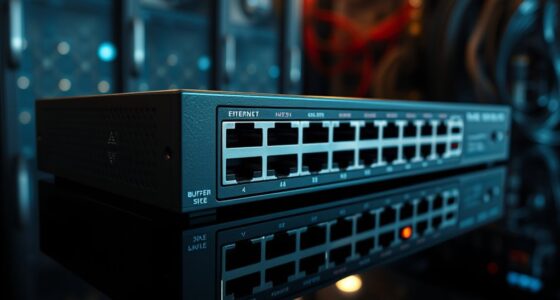Many believe that simply having a network security system is enough to protect sensitive information, but the reality is more complex. Effective access control and clear policies are essential to truly safeguard your environment. Without them, vulnerabilities can easily surface, leaving your organization exposed. Understanding how these policies work and how to implement them correctly can make a significant difference. Are you confident your current approach is enough to stop evolving cyber threats?
Key Takeaways
- Network policies define rules to regulate who can access resources and under what conditions, ensuring security and compliance.
- Access control manages user identities and permissions, verifying legitimacy before granting network access.
- Technical tools like firewalls, ACLs, and role-based access control enforce policies and block unauthorized activities.
- Continuous monitoring and audits detect unusual activities, helping respond swiftly to security incidents.
- Regular policy updates and user education strengthen defenses against evolving cybersecurity threats.

In today’s digital landscape, understanding network policies and access control is indispensable for safeguarding your systems. These elements form the backbone of your cybersecurity strategy, guaranteeing that only authorized users and devices can reach sensitive data and resources. When you implement effective policy enforcement, you’re actively managing how your network responds to different access requests. This process involves setting clear rules that dictate who can access what, when, and under what conditions. By doing so, you maintain control over your network environment and reduce the risk of unauthorized activities.
Access management is at the heart of this effort. It’s about controlling user identities and permissions so that each individual or device has appropriate access levels. When you establish robust access management practices, you’re fundamentally creating a gatekeeper system that verifies identities before granting entry. This verification can involve multiple layers, such as passwords, biometric checks, or device certificates, to confirm legitimacy. Proper access management also means regularly reviewing permissions, revoking outdated rights, and adjusting policies as your organization evolves. This proactive approach helps prevent potential security gaps caused by outdated or excessive access rights.
To enforce your policies effectively, you need a combination of technical tools and strategic planning. Firewalls, intrusion detection systems, and access control lists (ACLs) are common tools that help you implement policy enforcement. These tools monitor traffic, block unauthorized attempts, and guarantee that only compliant devices and users gain entry. Additionally, implementing role-based access control (RBAC) allows you to assign permissions based on job functions, making sure users only access what’s necessary for their roles. This minimizes the chances of accidental or malicious data exposure.
Regular audits and monitoring are indispensable components of policy enforcement. By continuously analyzing access logs and network activity, you can identify unusual patterns that may indicate a breach or policy violation. This ongoing oversight allows you to respond swiftly, tighten controls, or update policies as new threats emerge. Educating your team about security policies and best practices also plays an integral role. When everyone understands the importance of access management and policy enforcement, they’re more likely to follow procedures and report suspicious activity. Additionally, understanding network policies and access control is essential for designing a secure and resilient network infrastructure capable of adapting to evolving threats.
Frequently Asked Questions
How Do Network Policies Adapt to Cloud Environments?
As you migrate to the cloud, network policies adapt by becoming more dynamic and automated. You implement policy automation tools to manage access control across hybrid environments seamlessly. Cloud migration requires you to update policies continuously to reflect new resources and security risks. This guarantees consistent enforcement, reduces manual errors, and keeps your network secure. By embracing these changes, you maintain control and agility in your cloud infrastructure.
What Are the Common Pitfalls in Implementing Access Controls?
Think of implementing access controls like building a fortress—if you misconfigure the gates, invaders slip through. Common pitfalls include misconfiguration risks that leave gaps for unauthorized access and inconsistent policy enforcement, creating weak spots. You might also overlook regular updates, making your defenses brittle over time. To keep your digital fortress secure, double-check your settings, enforce policies diligently, and stay vigilant against missteps that could compromise your network.
How Is User Behavior Monitored Within Network Policies?
You monitor user behavior through access monitoring tools that track user activity in real-time. These tools log actions like login times, accessed resources, and data transfers, helping you identify unusual patterns or potential security threats. By analyzing user activity, you can enforce policies more effectively, detect unauthorized access, and guarantee compliance. Regularly reviewing access logs and alerts allows you to stay proactive in maintaining network security and controlling user behavior.
What Role Does AI Play in Managing Network Security?
AI plays a vital role in managing network security by enabling automation and enhancing threat detection. It automatically analyzes network traffic, identifies unusual patterns, and flags potential threats in real-time. With AI, you can respond swiftly to security incidents, reducing response times and preventing data breaches. This technology continuously learns from new threats, improving its accuracy and helping you maintain a secure and resilient network environment.
How Do Policies Differ Across Various Organizational Sizes?
Think of organizational size like a kingdom; your policies must evolve accordingly. In smaller organizations, policies are straightforward, focusing on essentials. As your organization grows, you face increased complexity, requiring scalable policies that adapt to expanding organizational complexity. Larger entities implement more detailed access controls, layered policies, and automation to manage security efficiently. Your goal is to develop scalable policies that match your organization’s size, ensuring security without sacrificing flexibility.
Conclusion
By implementing strong network policies and access controls, you substantially reduce the risk of cyber breaches. Did you know that organizations with regular permission reviews experience 30% fewer security incidents? Staying vigilant with role-based controls, multi-factor authentication, and ongoing staff training keeps your digital environment secure. Remember, continuous monitoring and policy updates are key to staying ahead of evolving threats, ensuring your network remains resilient and protected from unauthorized access.








